Transform Your Outdoor Spaces with Expert Landscaping by Landscape Gardeners
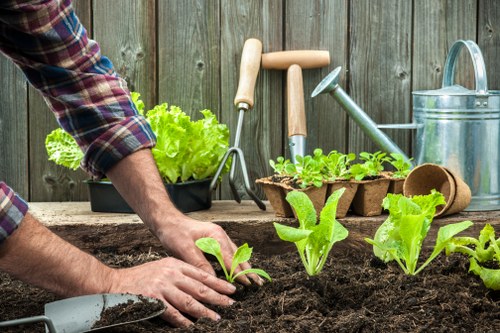
Landscaping is more than just planting some flowers or laying down sod; it's an art and science that transforms outdoor spaces into aesthetically pleasing and functional areas. Landscape gardeners play a crucial role in this transformation, bringing creativity, expertise, and a deep understanding of plant science to every project they undertake.
Whether you're looking to revamp your backyard, create a serene garden retreat, or enhance the curb appeal of your home, landscape gardeners are equipped with the skills and knowledge to make your vision a reality. Their services go beyond mere gardening; they encompass design, planning, installation, and maintenance of landscapes that are both beautiful and sustainable.
In this comprehensive guide, we'll delve into the world of landscape gardening, exploring the various aspects that make it an essential part of creating a harmonious outdoor environment. From design principles and plant selection to sustainable practices and maintenance tips, discover how landscape gardeners can elevate your outdoor living experience.
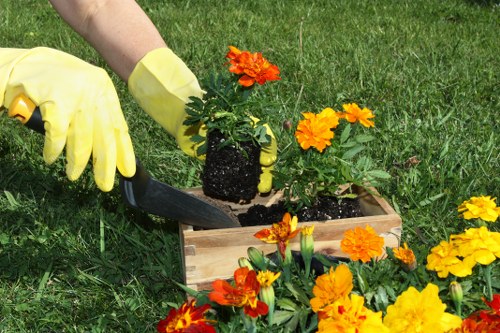
The Art of Landscape Design
At the heart of every stunning landscape is a well-thought-out design. Landscape design involves arranging elements such as plants, water features, pathways, and structures in a way that enhances both the beauty and functionality of the space.
Key Principles of Landscape Design:
- Unity and Harmony: Ensuring that all elements work together cohesively.
- Balance: Distributing visual weight evenly across the landscape.
- Proportion: Choosing elements that are appropriately sized for the space.
- Focal Points: Creating areas of interest to draw the eye.
Landscape gardeners adeptly apply these principles to create environments that are not only visually appealing but also comfortable and practical for everyday use.
Creating Functional Spaces
Functionality is a critical aspect of landscape design. Whether it's a space for relaxation, entertainment, or gardening, each area should serve a specific purpose without compromising the overall aesthetic.
Landscape gardeners assess the needs and preferences of their clients to design spaces that are both beautiful and functional. This might involve designing outdoor kitchens, seating areas, play zones for children, or dedicated spaces for specific types of plants.
By integrating functionality into the design, landscape gardeners ensure that your outdoor space is not only a feast for the eyes but also a practical extension of your home.
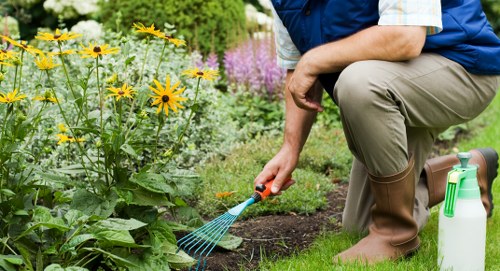
Plant Selection and Arrangement
One of the primary responsibilities of landscape gardeners is selecting the right plants for a given environment. This involves understanding the local climate, soil conditions, and the specific needs of each plant species.
Factors to Consider When Selecting Plants:
- Climate Compatibility: Choosing plants that thrive in the local weather conditions.
- Soil Type: Ensuring the soil can support the chosen plants.
- Sunlight Requirements: Placing plants in areas that match their sunlight needs.
- Water Needs: Grouping plants with similar watering requirements.
Proper arrangement of plants is also crucial. Landscape gardeners strategically position plants to create layers, add texture, and provide year-round interest. They consider factors like height, color, and bloom time to ensure a harmonious and dynamic landscape.
Seasonal Considerations
Creating a landscape that looks beautiful throughout the year requires careful planning. Landscape gardeners select a variety of plants that bloom in different seasons, providing continuous color and interest.
By incorporating evergreens, deciduous trees, flowering shrubs, and seasonal annuals, they ensure that your garden remains vibrant and engaging no matter the time of year.
This attention to seasonal variation not only enhances the aesthetic appeal but also supports local wildlife by providing habitats and sources of food year-round.
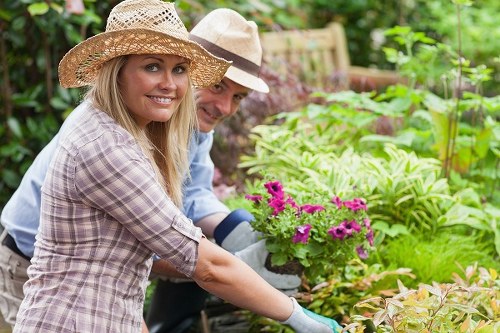
Sustainable Landscaping Practices
In today's world, sustainability is a key consideration in all aspects of life, including landscaping. Landscape gardeners are increasingly adopting eco-friendly practices to create beautiful yet sustainable outdoor spaces.
Eco-Friendly Landscaping Techniques:
- Native Plant Selection: Using plants that are native to the region reduces the need for excessive watering and maintenance.
- Efficient Irrigation Systems: Implementing drip irrigation or rainwater harvesting to conserve water.
- Organic Gardening Practices: Avoiding chemical fertilizers and pesticides in favor of natural alternatives.
- Soil Conservation: Maintaining soil health through mulching, composting, and minimal disturbance.
By embracing these sustainable practices, landscape gardeners not only create attractive landscapes but also contribute to the health of the environment.
Energy Efficiency and Planting for Shade
Strategic planting can significantly impact the energy efficiency of a home. Landscape gardeners design landscapes that provide natural shading, reducing the need for air conditioning during hot months.
Deciduous trees are particularly effective, as they offer shade in the summer while allowing sunlight to pass through in the winter when their leaves have fallen. This natural climate control can lead to substantial energy savings and a reduced carbon footprint.
Additionally, evergreen shrubs can act as windbreaks, protecting the home from cold winter winds and further enhancing energy efficiency.
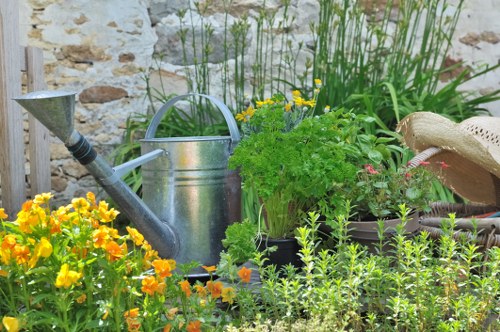
Hardscaping: Enhancing the Structure
Hardscaping refers to the non-living elements of a landscape, such as pathways, patios, walls, and water features. These elements provide structure and functionality, complementing the living components of the landscape.
Common Hardscape Features:
- Patios and Decks: Creating spaces for outdoor dining and relaxation.
- Walkways and Paths: Guiding movement through the landscape.
- Retaining Walls: Managing elevation changes and preventing soil erosion.
- Water Features: Adding tranquility with ponds, fountains, or waterfalls.
Landscape gardeners expertly integrate these hardscape elements to enhance the overall design, ensuring that they are both functional and visually appealing.
Choosing the Right Materials
Selecting appropriate materials is crucial for the durability and aesthetics of hardscape features. Landscape gardeners consider factors like climate, maintenance requirements, and design style when choosing materials.
From natural stone and pavers to concrete and wood, each material offers unique benefits and contributes to the overall look and feel of the landscape.
By choosing high-quality, sustainable materials, landscape gardeners ensure that hardscape features stand the test of time and continue to enhance the landscape for years to come.
Lighting and Ambiance
Outdoor lighting plays a vital role in extending the usability of outdoor spaces and creating a captivating ambiance. Landscape gardeners design lighting schemes that highlight key features, ensure safety, and add a magical touch to the landscape.
Types of Landscape Lighting:
- Path Lighting: Illuminating walkways to ensure safe navigation at night.
- Accent Lighting: Highlighting architectural features, plants, or water elements.
- Deck and Patio Lighting: Creating inviting spaces for evening gatherings.
- Flood Lighting: Providing security by illuminating larger areas.
Effective lighting design enhances the beauty of the landscape while serving practical purposes, making outdoor spaces enjoyable after dark.
Energy-Efficient Lighting Solutions
With the growing emphasis on sustainability, landscape gardeners are adopting energy-efficient lighting solutions. LED lights, solar-powered fixtures, and motion-sensor lights reduce energy consumption and minimize environmental impact.
By integrating these technologies, they create beautiful, well-lit landscapes that are both eco-friendly and cost-effective.
Moreover, strategic placement of lighting can reduce the number of fixtures needed, further conserving energy and enhancing the overall design.
Maintenance and Care
Maintaining a beautiful landscape requires regular care and attention. Landscape gardeners not only design and install landscapes but also provide ongoing maintenance to ensure that the outdoor spaces remain healthy and vibrant.
Essential Maintenance Practices:
- Pruning and Trimming: Maintaining the shape and health of plants.
- Weeding: Keeping unwanted plants at bay to prevent competition for resources.
- Fertilizing: Providing nutrients to support plant growth.
- Irrigation Management: Ensuring plants receive adequate water without overwatering.
Regular maintenance not only keeps the landscape looking its best but also extends the lifespan of plants and hardscape elements.
Seasonal Maintenance
Different seasons bring unique challenges and maintenance needs. Landscape gardeners adjust their maintenance routines to address issues like winter protection, spring planting, summer watering, and fall cleanup.
By tailoring maintenance practices to the seasons, they ensure that the landscape remains healthy and resilient throughout the year.
Seasonal maintenance also involves preparing plants and structures for extreme weather conditions, safeguarding the investment you’ve made in your outdoor space.
Choosing the Right Landscape Gardener
Selecting a skilled and reliable landscape gardener is crucial to the success of your project. Here are some tips to help you make the right choice:
- Experience and Portfolio: Review their past projects to gauge their style and expertise.
- Reputation: Look for reviews and testimonials from previous clients.
- Licensing and Insurance: Ensure they are properly licensed and insured to protect your property.
- Communication Skills: Choose a gardener who listens to your needs and communicates effectively.
- Sustainability Practices: If environmental responsibility is important to you, select a gardener who prioritizes sustainable practices.
By carefully evaluating potential landscape gardeners, you can ensure that your project is in capable hands and that the final result aligns with your vision.
Consultations and Estimates
Many landscape gardeners offer consultations to understand your needs and provide estimates for the project. During this phase, discuss your ideas, budget, and any specific requirements you may have.
Clear communication during consultations helps in setting realistic expectations and ensures that both parties are aligned on the scope and objectives of the project.
Don’t hesitate to ask questions and request detailed proposals to make an informed decision.
Cost Considerations
The cost of landscaping can vary widely based on factors such as the size of the project, materials used, and complexity of the design. It’s essential to establish a budget early on to guide the planning and execution process.
Factors Influencing Landscaping Costs:
- Design Complexity: More intricate designs with multiple elements tend to cost more.
- Material Quality: High-quality materials may have a higher upfront cost but offer greater longevity and aesthetic appeal.
- Labor: Skilled labor involved in specialized tasks can influence overall costs.
- Maintenance Requirements: Landscapes that require frequent upkeep may incur ongoing costs.
It’s advisable to obtain multiple quotes and compare the offerings to ensure you’re getting the best value for your investment.
Long-Term Investment
While landscaping requires an initial investment, it’s a long-term asset that can enhance the value of your property, provide enjoyment, and reduce maintenance costs over time.
Well-designed and maintained landscapes can increase property values, making them a worthwhile investment for homeowners.
Consider landscaping as an investment in your home’s future, contributing to both immediate pleasure and long-term benefits.
Innovative Trends in Landscaping
The field of landscaping is continually evolving, with new trends and innovations shaping the way outdoor spaces are designed and maintained. Staying informed about these trends can inspire fresh ideas and enhance your landscape’s appeal.
Current Landscaping Trends:
- Edible Gardens: Incorporating fruits, vegetables, and herbs into the landscape for sustainable living.
- Outdoor Living Spaces: Creating fully equipped outdoor kitchens, lounges, and entertainment areas.
- Water Conservation: Utilizing drought-resistant plants and efficient irrigation systems.
- Smart Landscaping: Integrating technology for automated watering, lighting, and climate control.
Embracing these trends can make your landscape more functional, sustainable, and aligned with modern lifestyles.
Biophilic Design
Biophilic design emphasizes the connection between humans and nature, integrating natural elements into the built environment to promote well-being. This trend encourages the use of natural materials, abundant greenery, and water features to create calming and restorative outdoor spaces.
Landscape gardeners adept at biophilic design can create environments that not only look beautiful but also enhance mental and physical health.
Incorporating biophilic principles can make your outdoor space a sanctuary that nurtures your connection to nature.
Conclusion
Landscape gardening is a multifaceted discipline that combines artistry, technical knowledge, and a passion for creating beautiful outdoor spaces. Landscape gardeners are skilled professionals who can transform your vision into reality, crafting landscapes that are both stunning and functional.
From the initial design phase to the selection of plants and hardscape elements, and through to maintenance and sustainability practices, landscape gardeners ensure that every aspect of your outdoor space is thoughtfully considered and expertly executed.
Investing in professional landscaping not only enhances the beauty and value of your property but also provides a personal retreat that you can enjoy for years to come. Contact us today to start your journey towards a breathtaking and harmonious landscape.